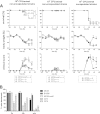Invasive potential of nonencapsulated disease isolates of Neisseria meningitidis
- PMID: 22508859
- PMCID: PMC3416473
- DOI: 10.1128/IAI.00293-12
Invasive potential of nonencapsulated disease isolates of Neisseria meningitidis
Abstract
The capsule of Neisseria meningitidis is the major virulence factor that enables this bacterium to overcome host immunity elicited by complement and phagocytes, rendering it capable of surviving in blood. As such, nonencapsulated N. meningitidis isolates are generally considered nonpathogenic. Here, we consider the inherent virulence of two nonencapsulated N. meningitidis isolates obtained from our national surveillance of infected blood cultures in Canada. Capsule deficiency of both strains was confirmed by serology and PCR for the ctrA to ctrD genes and siaA to siaC genes, as well as siaD genes specific to serogroups B, C, Y, and W135. In both strains, the capsule synthesis genes were replaced by the capsule null locus, cnl-2. In accordance with a lack of capsule, both strains were fully susceptible to killing by both human and baby rabbit complement. However, in the presence of cytidine-5' monophospho-N-acetylneuraminic acid (CMP-NANA), allowing for lipooligosaccharide (LOS) sialylation, a significant increase of resistance to complement killing was observed. Mass spectrometry of purified LOS did not reveal any uncommon modifications that would explain their invasive phenotype. Finally, in a mouse intraperitoneal challenge model, these nonencapsulated isolates displayed enhanced virulence relative to an isogenic mutant of serogroup B strain MC58 lacking capsule (MC58ΔsiaD). Virulence of all nonencapsulated isolates tested was below that of encapsulated serogroup B strains MC58 and B16B6. However, whereas no mortality was observed with MC58ΔsiaD, 5/10 mice succumbed to infection with strain 2275 and 2/11 mice succumbed to strain 2274. Our results suggest the acquisition of a new virulence phenotype by these nonencapsulated strains.
Figures



References
-
- Abdillahi H, Poolman JT. 1987. Whole-cell ELISA for typing Neisseria meningitidis with monoclonal antibodies. FEMS Microbiol. Lett. 48:367–371 - PubMed
-
- Ashton FE, Ryan A, Diena BB, Frasch CE. 1979. Evaluation of the antiserum agar method for the serogroup identification of Neisseria meningitidis. Can. J. Microbiol. 25:784–787 - PubMed
-
- Borrow R, et al. 1998. siaD PCR ELISA for confirmation and identification of serogroup Y and W135 meningococcal infections. FEMS Microbiol. Lett. 159:209–214 - PubMed
Publication types
MeSH terms
Substances
LinkOut - more resources
Full Text Sources
Other Literature Sources
Medical
Research Materials

